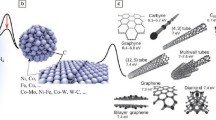Abstract
Nanostructures tend to comprise distinct and measurable forms, which can be referred to in this context as nanopatterns. Far from being random, these patterns reflect the order of well-understood chemical and physical laws. Under the aegis of said physical and chemical laws, atoms and molecules coalesce and form discrete and measurable geometric structures ranging from repeating lattices to complicated polygons. Rules from several areas of pure mathematics such as graph theory can be used to analyze and predict properties from these well-defined structures. Nanocarbons have several distinct allotropes that build upon the basic honeycomb lattice of graphene. Because these allotropes have clear commonalities with respect to geometric properties, this paper reviews some approaches to the use of graph theory to enumerate structures and potential properties of nanocarbons. Graph theoretic treatment of the honeycomb lattice that forms the foundation of graphene is completed, and parameters for further analysis of this structure are analyzed. Analogues for modelling graphene and potentially other carbon allotropes are presented.
Similar content being viewed by others
References
A. T. Balaban, J. Chem. Inf. Comp. Sci. 25, 334 (1985).
E. Estrada. Graph and Network Theory in Physics. WWW Document. (http://arxiv.org/abs/1302.4378).
R.D. Cormia, J.N. Johnsen. Nanotech. IEEE Proc., 11, 942 (2011).
A. Marr and W.D. Wallis, Magic Graphs, 2nd Ed. (Springer, New York, 2013), pp. 15–23.
S-M Lee, H-H Su, and Y-C Wang, Cong. US Numer. 193, 49 (2008).
G. S. Bloom and S.W. Golomb, Lec. Notes in Math. 642, 53 (1978).
G. S. Bloom and S. W. Golomb, Proc. IEEE 65, 562 (1977).
M. Baca. Disc. Math. 105, 305 (1992).
A. Baker and J. Sawada, Lec. Notes Comp. Sci. 5165, 361 (2008).
V. S. Yakovlev, M. I Stockman, F. Krausz and P. Baum, Sci. Rep. 5: 14581, (2015).
U.S. Army Materiel Command, CC BY 2.0. “Scanning probe microscopy image of graphene,” (2012).
Tomruen (Own work), CC BY-SA 4.0. “Hexagonal Lattice,” (2015).
E. W. Weisstein. “Hexagonal Grid.” WWW Document. (http://mathworld.wolfram.com/HexagonalGrid.html).
E. W. Weisstein. “Graph.” WWW Document. (http://mathworld.wolfram.com/Graph.html).
E. W. Weisstein. “Magic Graph.” WWW Document. (http://mathworld.wolfram.com/MagicGraph.html).
J. Park, G. He, R. M. Feenstra, A. Li. “Atomic-Scale Mapping of Thermoelectric Power on Graphene: Role of Defects and Boundaries.” Nano Lett. 13, 3269 (2013).
Author information
Authors and Affiliations
Rights and permissions
About this article
Cite this article
Fagnan, E., Cormia, R. Graph-Theoretic Analysis of Nanocarbon Structures. MRS Advances 1, 1761–1766 (2016). https://doi.org/10.1557/adv.2016.113
Published:
Issue Date:
DOI: https://doi.org/10.1557/adv.2016.113




